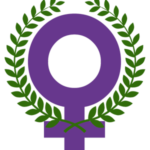3.Why focus on young women and girls?
National prevalence of violence against women and girls
Since VWC’s establishment, it has focused on violence against both women and children. National Children’s Day has always been used by VWC as an entry point for raising awareness of the particular types of violence faced by girls and boys and its impacts. Nevertheless, for many years there was a persistent view held by some in the community that VWC’s services were only appropriate or relevant to older women or married women with children (“mamas”), rather than younger women and girls who have not yet had children.
“Almost every form of violence is more prevalent for young women”
VWC’s 2009 national prevalence survey opened a door to women’s lives, by challenging Vanuatu’s view of itself as a nation that values and protects family and children.[i] One of the most important findings was that almost every form of violence is more prevalent among young women (Box 2 and 3).

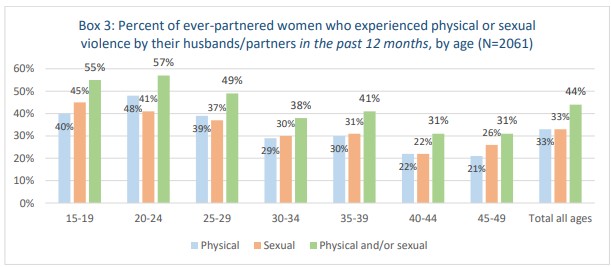
Whereas 60% of all women in Vanuatu experienced physical and/or sexual violence in their lifetime by an intimate partner, women under 29 have the highest prevalence (Box 2). This is somewhat more marked in the previous 12 months before the survey, with 55%-57% of women under 29 living with violence, compared with 44% nationally (Box 3).
Similar patterns exist for emotional violence by husbands and partners, and for most of the various types of coercive control that husbands and intimate partners exert over women of all ages (Box 4).
Box 4: Emotional violence and coercive control over young women
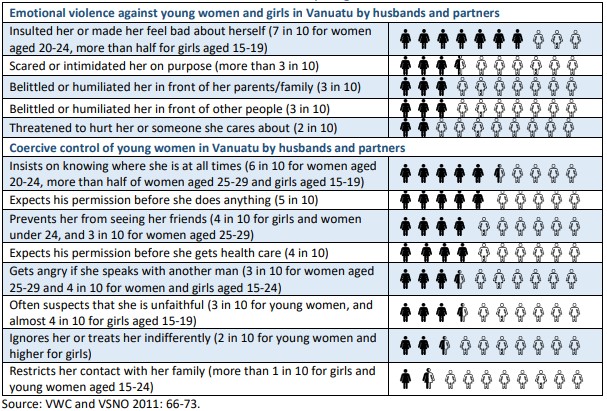
Overall, 68% of women in Vanuatu are emotionally abused by their husbands and intimate partners during their lifetime, and 54% in the previous 12 months before the survey was undertaken. Emotional violence starts early in relationships – young women aged 20 to 29 have a high prevalence of each type of emotional violence and most types of coercive control, and many of these forms of abuse and control persist throughout a woman’s life. (VWC and VNSO 2011: 68-73.)
VWC’s national research also showed that the prevalence of sexual abuse against girls under the age of 15 is one of the highest in the world. Almost 1 in 3 of the women who did the survey were sexually abused before the age of 15 years (30%), and the majority of perpetrators were male family members and boyfriends. For 28% of women, their first sexual experience is forced.[ii] Overall, more than 1 in 4 women (28%) are physically abused by someone other than their husband or partner – and again, the prevalence rates are higher for girls aged 15-19 (37%) and young women aged 20-24 (32%).[iii]
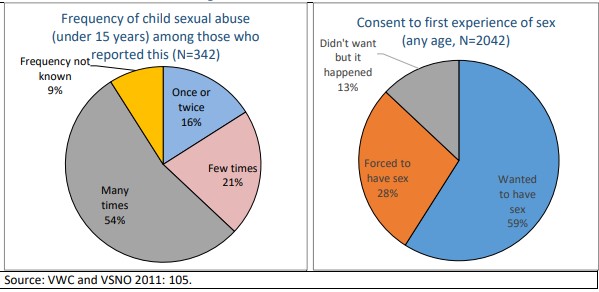
All these findings are particularly disturbing because VWC’s national survey also showed that non-partner physical violence and child sexual abuse are both significant risk factors that increase the likelihood that women will be subjected to violence by their husbands and partners later in life.[iv]
1 in 3 women are sexually abused before 15 years of age, mainly by male family members and boyfriends. (VWC and VNSO 2011: 100-103.)
National data from Vanuatu Correctional Services on sexual offences against young women and girls[v]
A study by the Vanuatu Department of Correctional Services found that sexual offenders made up approximately 60% of all offenders dealt with by the department in 2016. Most of the victims of these crimes were very young: 52% were under 15 years, and 31% were aged between 16 and 20. All but one of the victims were female, and the one male victim was a 12-year old boy. Ages of the victims ranged from 3 years old to a 69-year old blind woman.
In contrast with the age profile for victims, approximately 20% of offenders were under 20 years old, and only 3% were under 15. The age of offenders ranged from 11 to 72, and 59% were over 26 when they committed their sexual offence.
83% of victims of sexual offences are young women and girls under 20 years old. In contrast, about 20% of offenders are under 20. “Offenders included fathers, uncles, grandfathers, husbands/boyfriends, youth group leaders, village chiefs, pastors and village acquaintances.”
Sadly, 90% of the victims knew their offenders, and 61% were in the same family and living in the same household as their offender. The most common offences were for rape/sexual intercourse without consent (73%); the remainder were for sexual intercourse with a child under protection (8%), indecent assault of a young person under 13 (9%), and incest (8%).
With this profile of offenders, it is not surprising that the study found that the majority of offences occurred in people’s homes and villages; 61% occurred in rural areas, 12% of offenders were reported to have a leadership role in their churches, and 9% were repeat sex offenders. Offenders came from a wide range of employment and education backgrounds. Of the 120 offences committed, there were 9 gang rapes, and most of the male offenders in gang rapes were under 26. The exception to this pattern was 2 cases where women were also convicted of sexual assault; in both instances, the offence was committed with their husbands against vulnerable or dependent family members.
In 88% of the offences, no record of drugs or alcohol were reported as contributing factors. However, the high proportion of cases where additional violence was used is alarming, although not surprising to VWC, where women share many stories every day of sexual attacks being accompanied by either extreme physical violence, or threats: additional violence was used in 55% of offences, and threats were made in a further 22% of cases.
In 9% of the offences, children were bribed to comply with the assaults. Other violence was used during attacks including being punched and hit with fists or rocks, strangled or suffocated, cut with knives, dragged and tied up, and held down while raped by other offenders.
The Department’s report notes that it was difficult for the study to find information about the impact of sexual offences on victims. However, some important findings were listed that resonate very strongly with VWC’s counselling experience, and with findings from the VWC national prevalence survey. For example, the Department’s report notes that the victim and sometimes her mother needed to move from the village home to another island, children were unable to concentrate and continue with their schooling, and that women found it difficult to continue to work following such assaults. A range of reproductive, physical and other mental health impacts were also mentioned, along with a tendency for women and girls to be re-victimised when offenders returned to the family home on parole.
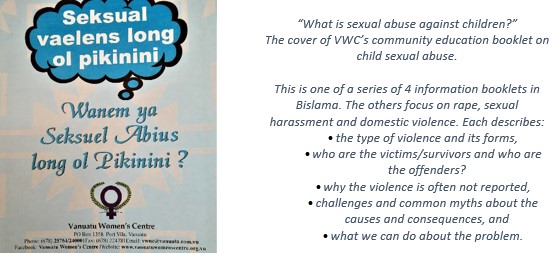
[i] Ibid: 14.
[ii] Ibid: 17, 103-104.
[iii] Ibid: 17, 95-96. The survey did not interview girls under 15 years of age.
[iv] Ibid: 17.
[v] All the data in this section is quoted from: Dipatmen Blong Koreksonal Sevis 2017 Offending Against Morality in Vanuatu – Sexual Offenders: A Demographic Profile, 2017, Vanuatu Correctional Services, Port Vila.
